Dow Jones Total Market Groups & Foreign Stocks
Bad habits are just that; repeating patterns of behavior that ultimately lead to some undesirable outcome. I like my tobacco and whiskey. A cloud of smoke hangs over me whenever I'm charting or writing, though I'm drinking coffee or tea when I'm at the keyboard. After a few hours of writing, sometime after midnight, darned it if I don't deserve a little booze. I don't drink much; a quart (liter) lasts me about ten to fifteen days. The only redeeming factor in my abuse of tobacco and whiskey is the enjoyment I get from them.
But some bad habits are downright pernicious, like smoking crack cocaine. I don't think anyone addicted to a hard narcotic enjoys their bad habit. Hard-core addicts just keep doing it until they either die or kick the habit, exactly like people who invest in high-tech and financial stocks. Take a look at high-tech's ten year performance shown in the table below. The data is from Barron's 29 Oct 2001 & 31 Oct 2011 issues, so we are looking at ten year returns.
High-tech's best performing index is digital hardware (#32), with a ten-year return of 96%. Not bad. It didn't beat CRB's Continuous Contract Index (#12), but it was still well above CinC (#43) and CPI (#70). But the fact is, we have to look south of #59 to find the rest of the high-tech indexes, with software (#64) up only 35%, and semiconductors (#83) down -10% from ten years ago! Good thing I didn't decide to use these indices' prices from their bubble highs of 2000. In less than two years, from January 2000 to October 2001, semiconductors and software crashed 64%, and 65% from their bubble market highs.
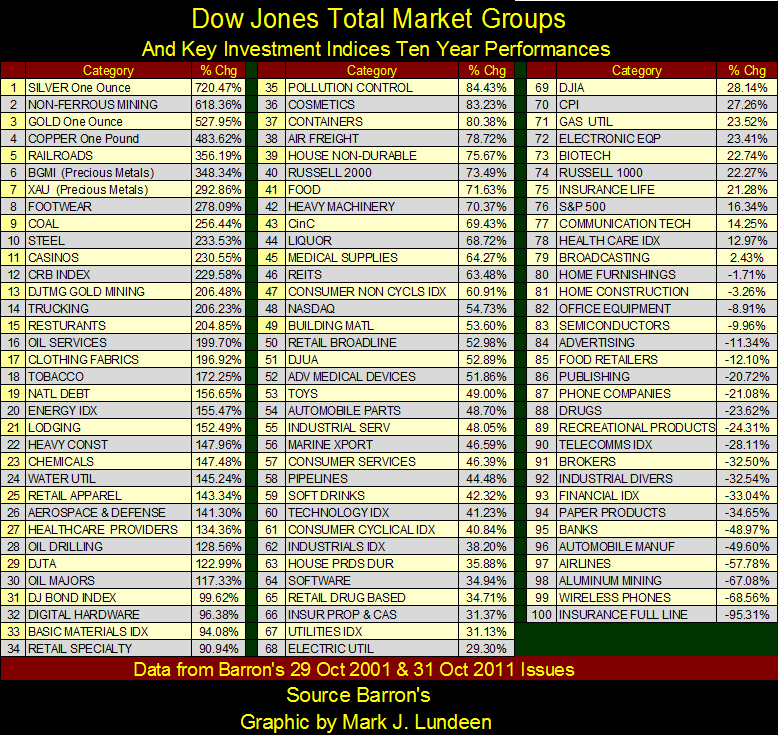
But those who staked their capital investing in financial shares make high-tech investors look like wizards of finance. The best performer of all the financials was property and casualty insurers (#66) with a ten year of gain 31.37%. They beat the CPI index (#70), but how hard is that? Pretty hard if you invested in life insurance, which came in at #75. Then there are the rest of the financial indexes, which all posted losses greater than 30% over the past ten years. These losses are even more significant, considering that the Federal government, and its creature the Federal Reserve, have "injected" trillions of dollars in stimulus, and outright bailouts since 2008. Doctor Bernanke at one point during the crisis had to extend North American and European banks more credit than the entire US national debt. Today, the global financial system is as unstable as it is corrupt.
I was watching CNBC's Jim Cramer's Mad Money on Monday doing his Halloween show. He had a list of investing mistakes he's made over the years, like recommending mining stocks (#2,6,7,&13 in the table above). I like Jim. But he gets shifty every now and then, like last Monday when he chose to show charts of major gold miners that only covered the correction of the last six months. He knows better than that. But in his favor, he does like gold (#3). However, he omitted the #1 performer of the past ten years: silver, in his recommendation list. Anytime the #1 investment of the past decade is totally ignored by the majority of the "experts" on Wall Street, it's a good indication that whatever it is, it has a long ways to go before it tops out.
But after a ten year losing streak, isn't it about time for high-tech and financials to begin a new bull market? And aren't precious metals getting stale in their ten year run? In 2011, I'd advise my readers to reject the "buy them on a bounce" and "what goes up must come down" theories of investing. What is the flaw in that logic? Because before high-tech and financial stocks become attractive again, they first have to become * OUT OF FAVOR STOCKS *; stocks that once were loved, but now are widely hated by both the public and the media. Investors hate out-of-favor stocks for all the money they've lost, and the media for the opprobrium they've brought to their "market experts". No doubt about it, high-tech and financial stocks have cost their owners a lot of money over the past decade, but they have yet to become objects of hatred, contempt and scorn by investors and the media.
If you want to see hatred, contempt and scorn for an out-of-favor investment class on the rebound, we need only look at media coverage of precious metals and their miners, the best performing assets of the past decade. Contrarian logic tells us that this is the best indication that the bull markets in gold, silver and mining shares still have far to go.
A perfect example of what a hard bear bottom looks like, followed by the early stages of a new bull market, is the below BEV chart of 1969 to 2011 price of gold. Gold declined by 70% from its high of January 1980, to its bottom in February 2001. For two solid decades, every time gold saw a bounce off the basement floor, its friends were ready to proclaimed that the worst was over, and gave it a "strong buy" recommendation for its outstanding investment potential. After 1996, people got tired of listening to the "gold bugs." By 1999, even hard-core gold bugs filed for divorce for reasons of emotional abuse, and began investing in high-tech stocks. Then, in 2001 with gold at $255, it became the most hated asset the world had ever known. It was at this point that it began rising, and gold has never looked back.

To this day, ten years after the bottom of a 21 year bear market, even after ten straight years of gains totaling 528%, the general public still wants nothing to do with gold. This is actually very positive for the continuing outlook on precious metals investments, since it indicates that the sector has not yet attracted the affections of the general public. But someday it will!
So, what is John Q Public currently investing in? Well, if you follow trading volume, it would seem to indicate high-tech and financial shares are as popular as ever. In other words, gullible people still love the hot stocks of the high-tech and the housing bubbles. Look at the table below, where I've listed weekly trading volume, as a percentage of total trading volume for each market group within the Dow Jones Total Market Industry Groups. In other words, in Barron's October 31, 2011 issue, the banking index (#1 below) consumed 12.04% of the total trading volume during the week of 24-28 October 2011. High tech's semiconductors and software companies (#2&3) consumed another 13.73% of last week's total volume. Together, the top three indexes, all decade long losers, comprised a full 25% of last week's trading volume. In the stock market, this is what love looks like.
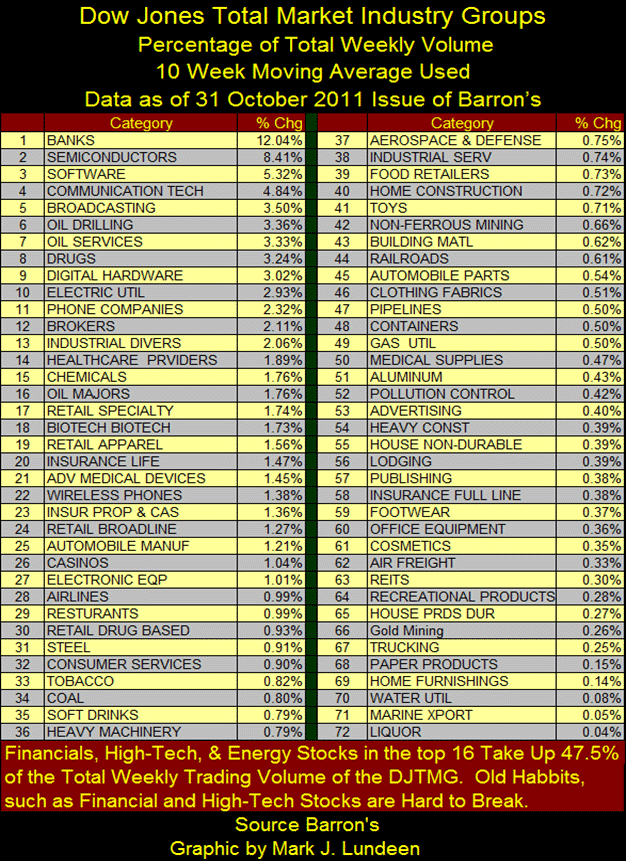
What about gold? It's way down on the list at #66 of 72, with only 0.26% of the total. But this table is only a snap-shot in time of a single week's trading volume. Let's look at the volume trends in these market groups since 1989, when Dow Jones first began publishing their Dow Jones Total Market Groups (DJTMG).
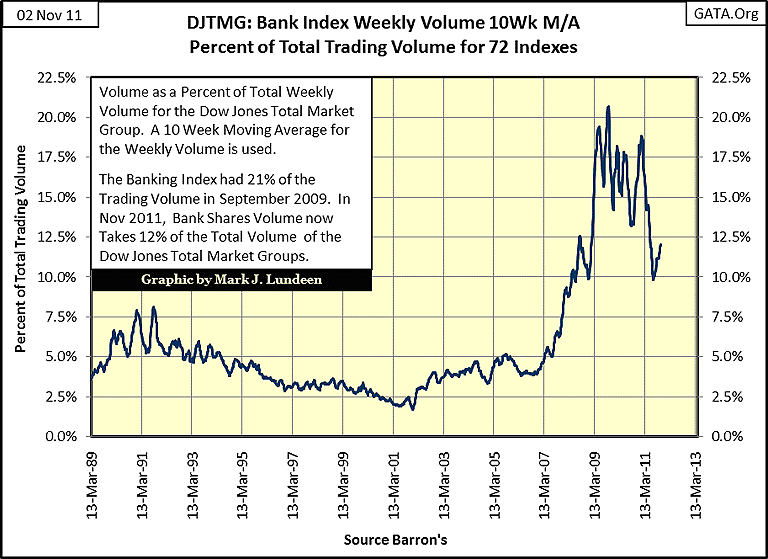
Above, we see the ten week moving average of the Banks' percentage of total weekly trading volume from 1989 through last week. Remember, this chart only shows the PERCENTAGE of banking stocks' volume compared to the total trading volume of all 72 indexes in the DJTMG. This being the case, there are times when the banks' actualtrading volume is rising, while their percentage of total volume is declining. This is precisely the case from 1991 to 2001 when actual trading volume for banking shares increased by a factor of six. So why did banking shares'percentage of total trading volume shrinking over this same period? Because from 1989 to 2001, the actual volume for semiconductors and software stocks exploded by a factor of 200. During the 1990s the investing public discovered that true happiness was not possible unless one invested in Microsoft and Intel.
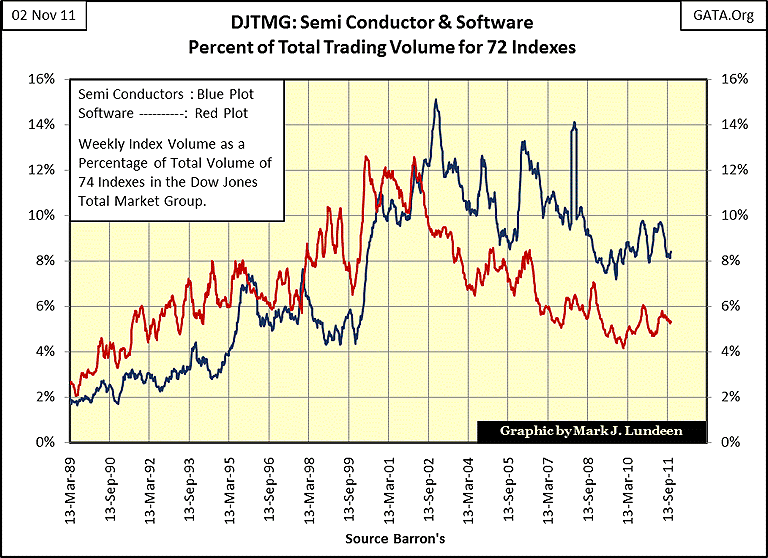
So, you can think of this data as a weekly public-opinion poll for the various stock groups in the DJTMG, from 1989 to 2011. My assumption is based on the fact that people buy what they like, and sell what they don't like. This being the case, it's logical that semi-conductors and software's position in the volume rankings (DJTMG's volume popularity poll) have declined since 2001. But what is unbelievable is seeing bank stocks increasing in popularity in the years leading up to the 2008-09 credit crisis, and then continuing on to become the most popular stock group over the past three years. A short duration volume spike could have been expected sometime from the late 2008 to early 2009, as the investing public exited the sinking bank stocks. But seeing banking shares absorb over 10% of total DJTMG's weekly trading volume for the past three years, as the value of the bank stocks crumbled 49% (see #95 in this article's first table) is an anomaly that can only be explained by high-frequency trading.
It's public knowledge that the stock exchanges, and its regulators, are allowing the big banks to use programmed trading, also called high-frequency trading in the market today. We know that these programs can be used to manipulate market values, because a former employee of Goldman Sachs stole Goldman's HFT software. They called the police, charging their former employee with theft of software, with the intent of illegally manipulating the market. Looking at the banking chart above, I think it's fair to say that Goldman, and other privileged NY financial institutions have been granted a Federal license to manipulate the market in financial shares.
Let's take a look at the volume for the DJTMG gold index. The first thing that stands out is that trading gold mining shares was more popular during its bear market (1989-2001) than after the bull market in gold began in 2001. Yes, since 2001 gold, silver and their miners have seen an explosion in their valuations, but the chart below is proof that since 2001, the investing public * HAS NOT * been enamored with one of the best performing assets of the past ten years: gold mining shares, although congressman Ron Paul surely has.
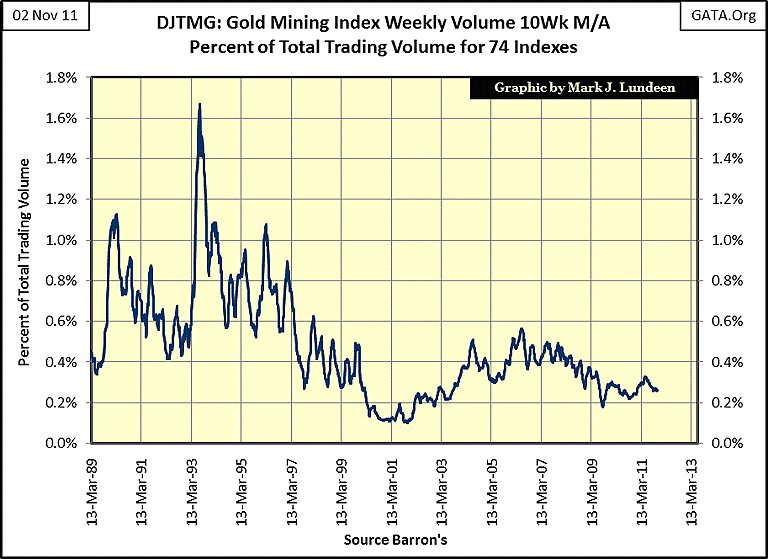
Take a look at the July 1993 spike in gold mining's volume above; at its peak the DJTMG's gold shares absorbed 1.65% of total DJTMG trading volume. Compare this with the banking stocks' percentage of total volume for November 2001, only 2.09%. These percentages are nearly the same. If current valuation trends in precious metals continue as expected, we should anticipate a mania developing in the gold mining shares. Don't assume that in a precious metals mania, the percentage of gold mining's volume to total trading volume couldn't explode to well above 10% of total DJTMG volume.
My expectations are that as gold, silver and mining shares continue their bull markets, the general public and financial fiduciaries will eventually exit the financial, and high-tech groups and begin buying mining shares. I agree with Ron Paul that the bull market in gold mining stocks is still in its early stages, and the bulk of its investment returns are still ahead of us. It's certainly not too late to get in. With average global gold production costs currently about $800 an ounce, and recent market prices ranging between $1700 and $1900 an ounce, the profit margin for gold miners is at record levels and still growing, which should eventually be reflected in their market price.
[email protected]
















